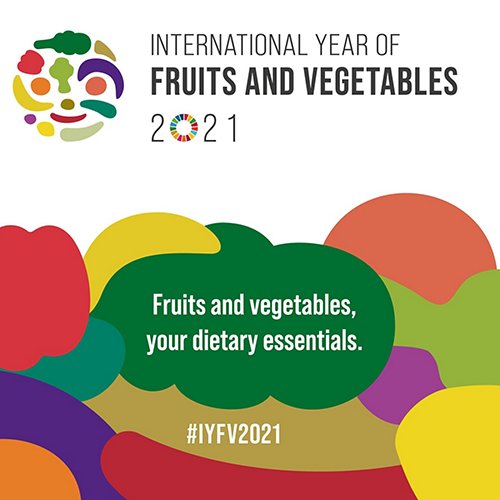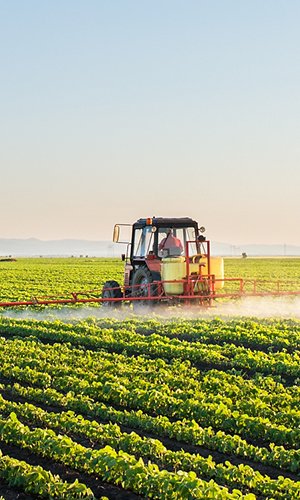This year has been designated by FAO (Food and Agriculture Organisation of the United Nations) as the International Year of Fruits and Vegetables (IYFV). Promoting a healthy diet and lifestyle, reducing food waste and losses, improving food production and making it more sustainable through innovation and technology are just some of the reasons why FAO and the United Nations have dedicated a year to a group of foods that are of fundamental importance to our health.
Voice search

International Year of Fruits and Vegetables 2021

IYFV 2021 is a unique opportunity to raise awareness of the importance of fruits and vegetables for human nutrition, food security and health, and to achieve the UN Sustainable Development Goals.
The objectives of the International Year of Fruits and Vegetables are detailed below.
IYFV 2021 objectives
- Raising public awareness and directing policies on the health and nutritional benefits of fruit and vegetable consumption.
- Promoting diversified, balanced, and healthy diets and lifestyles through fruit and vegetable consumption.
- Reducing losses and waste in fruit and vegetable food systems.
- Sharing best practices on:
- Promotion of consumption and sustainable production of fruits and vegetables that contributes to sustainable food systems;
- Improved sustainability of storage, transport, trade, processing, transformation, retail, waste reduction and recycling, as well as interactions among these processes;
- Integration of smallholders including family farmers into local, regional, and global production, value/supply chains for sustainable production and consumption of fruits and vegetables, recognizing the contributions of fruits and vegetables, including farmers’ varieties/landraces, to their food security, nutrition, livelihoods and incomes;
- Strengthening the capacity of all countries, specially developing countries, to adopt innovative approaches and technology in combating loss and waste of fruits and vegetables.
With these objectives in mind, a paper was created which, in addition to outlining the benefits of fruit and vegetable consumption, examines the various aspects of the fruit and vegetable sector from a food systems approach: from sustainable production and trade to loss and waste management. This paper provides an overview of the sector and a framework and a starting point for discussion for the Year, highlighting the interlinkages of stakeholders and key issues to be considered for action during the IYFV.
What are fruits and vegetables?
First, let’s try to understand which foods fall into the categories of fruits and vegetables. FAO defines fruit and vegetables as the edible parts of plants (e.g. seed-bearing structures, flowers, buds, leaves, stalks, shoots and roots), whether cultivated or harvested wild, in their raw or minimally processed state (i.e. processing that does not affect their fresh-like quality, such as washing, sorting, trimming, peeling, slicing or chopping).
This definition, therefore, excludes:
- Starchy roots and tubers such as cassava, potato, sweet potato and yams (although the leaves of these plants are eaten as vegetables).
- Dry grain legumes (pulses) unless harvested when immature.
- Cereals, including corn, unless harvested when immature.
- Nuts, seeds and oilseeds such as coconuts, walnuts and sunflower seeds.
- Medicinal, herbal plants and spices, unless used as vegetables.
- Stimulants such as tea, cacao and coffee.
- Processed and ultra-processed products made from fruits and vegetables (e.g. wine, spirits), plant-based meat substitutes, or fruit and vegetable products with added ingredients (e.g. packaged fruit juices, ketchup).
Processed products such as fruit juices or plant-based meat substitutes are another matter.
An apple a day…
There is a saying that an apple a day keeps the doctor away. Indeed, fruit and vegetables are essential parts of a healthy diet. They are a source of fibre, vitamins, minerals and phytochemicals that promote the well-being of our bodies, help strengthen our immune systems and reduce risk factors that cause diseases such as obesity, chronic inflammation, high blood pressure and high cholesterol. However, in order to make the most of their beneficial effects, fruit and vegetables must be consumed in sufficient quantities every day as part of a healthy and varied diet. In particular, the World Health Organisation recommends eating at least five portions (or 400 grams) of fruit and vegetables a day, introducing them from the age of six months of age and maintaining this habit throughout life. In many countries of the world, however, this is not the case, for example because these products are not always available throughout the year, or because there are insufficient refrigeration facilities or transport is complicated. Price also plays a role: it is easier to fill your stomach with cheaper foods such as carbohydrates. Furthermore, it should not be forgotten that not everyone is aware of the value of what we eat: we may enjoy the taste of fruit and vegetables, but if we ignore their nutritional value we consider them extras rather than mainstays of a healthy diet.
Fruit and vegetables, sustainable food?
Nutrient-rich foods such as fruit and vegetables have a lower environmental impact than carbohydrate-rich products such as cereals. However, intensive production using large amounts of fertilisers and pesticides may not be sustainable and may cause loss of biodiversity as well as water and soil pollution. There are about 400,000 plants in the world, of which no more than 80,000 are edible. Yet the world’s food supply depends on just 200 plant species, 12 species provide three quarters of the food we eat and only nine account for 66% of the total cultivated. A diet based on a few foods is not only not good for our health, but also not good for the planet! Indeed, basing a large part of the world’s food supply on a few species results in an increase in intensive farming and a loss of biodiversity. The effects of destruction of biodiversity in the food sector are often underestimated, while they are one of the highest risk factors for the survival of our food systems.
Waste and innovation
Fruit and vegetables are the foodstuffs that suffer the most from loss and waste. It is estimated that up to 50% of fruit and vegetables produced in developing countries are lost along the supply chain, i.e. between harvest and consumption, mainly due to the high perishability of fresh produce. If we consider that it can take up to 50 litres of water to produce one orange, it is easy to understand that loss of fruit and vegetables leads to a waste of increasingly scarce resources, such as soil and water. In addition, a large proportion of fruit and vegetables, which would be perfectly suitable for human consumption, is wasted along the food chain due to physical or aesthetic defects. The market has imposed aesthetic standards whereby ‘perfect-looking=good’, which sends tons of good quality fruit and vegetables straight into the bin.
In order to drastically reduce food loss, we need to work on the cold chain, invest in research and consider digital innovation as a fundamental vehicle for the sustainable development of the agri-food sector from field to table. The safety issue should not be underestimated: fruit and vegetables are rich in nutrients but can carry diseases or be contaminated with chemicals, especially if eaten raw and with the skin on. Innovation also needs to be within everyone’s reach to safeguard biodiversity, food security and the health of humans and the planet.
by Benedetta Palazzo



